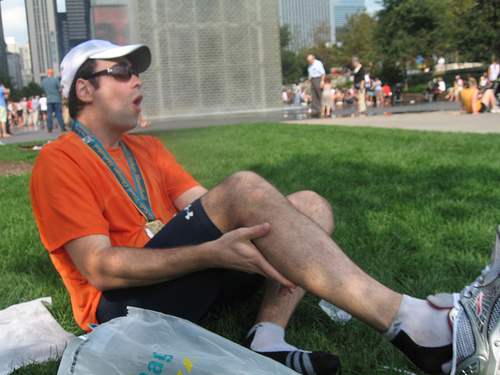 So you've got tight calves, cranky hip flexors, or a stiff neck. Most of us would reach for the foam roller, get a massage, or spend some time stretching. We'll do anything to release that tight, possibly painful muscle.
So you've got tight calves, cranky hip flexors, or a stiff neck. Most of us would reach for the foam roller, get a massage, or spend some time stretching. We'll do anything to release that tight, possibly painful muscle.
But a curious thing happens. It may feel better for a little while, but the familiar tightness returns minutes, hours, or a days later. In other words, the results are temporary.
So why is that?
As jacked up as someone may seem, your body creates that stiffness for a reason. An underlying movement dysfunction is usually to blame.
Let's take the calves, for example. Tight, rock hard calves. They may look sexy, but I can assure you they aren't too fun to run with!
Achilles' tendinopathy, plantar fasciosis, calf or foot cramping, and even knee pain are just some of the joys symptoms of those with tight calves.
So do we just stretch 'em all day? Not unless you want to have them rebound tighter and tighter!
 Thanks to Neurokinetic Therapy® (NKT), I can now answer that question. NKT® is a system developed by David Weinstock in California that assesses and treats the cause of the movement dysfunction. Many times, though not always, a movement dysfunction is at the root of that tight or achy muscle.
Thanks to Neurokinetic Therapy® (NKT), I can now answer that question. NKT® is a system developed by David Weinstock in California that assesses and treats the cause of the movement dysfunction. Many times, though not always, a movement dysfunction is at the root of that tight or achy muscle.
Here's How It Works.
During an assessment, I'm looking for muscles that aren't doing their job and the muscles that are compensating for them. Quite often when we restore function to the inhibited muscle, the tight muscle no longer has a reason to be tight.
A common example in runners is the calf to glute relationship. If you show up to every run with reduced neural drive to your glutes, you will have to get power or stability from somewhere else. I've seen people compensate with their low back, hamstrings, soles of their feet, and even the back of their neck. Almost anything can compensate for anything which is why you must be assessed.
As far as the brain knows, the calves are a great back-up option, but they'll get tighter the more you run. The calves are obligated to overwork. You're gonna run anyway and, without enough juice flowing to the glute muscle, your brain decides the best 'plan B' is to recruit the calves more.
Yes, You Will Have To Do Your Homework
Unlike going to get a massage where it's completely passive – you just lie there – hoping someone can fix you, NKT requires you to help yourself. You'll do that in 3 easy steps.
1. Using the tight calf example above, the client will have to begin by releasing their tight calves. A lacrosse ball or foam roller will work very well, but hands work great, too. I like to feel the tight muscle “melt” under the pressure (you don't need much) and this will take anywhere from 20-60 seconds.
2. Next, you'll take advantage of a short window of time when the motor control center of the brain is open to new learning. Immediately after releasing the tight muscle, you'll repeatedly activate the previously down-regulated muscle. In this case, the glutes. 10 reps of a simple glute bridge will work.
of time when the motor control center of the brain is open to new learning. Immediately after releasing the tight muscle, you'll repeatedly activate the previously down-regulated muscle. In this case, the glutes. 10 reps of a simple glute bridge will work.
Because the brain learns through repetition, you'll repeat steps 1 & 2.
3. Finally, to integrate the changes into your body, you'll need to move – this time with better motor control. This could mean practicing a move that you had difficulty with previously (like single leg balance or touching your toes), or simply walk around for 30 seconds.
NKT homework is perfectly suited to be part of the warm-up and cool-down session, too. You'll show up to your run with better motor control and, in case you overdo things while running (runners never do that!), you'll restore proper control so that you're not compensating for the rest of your day.
Frankly, I've found including NKT in my assessment sessions to be invaluable in helping people move and run better. Interested in figuring out why your tight spots keep coming back? Contact me now and we'll get to the source!
